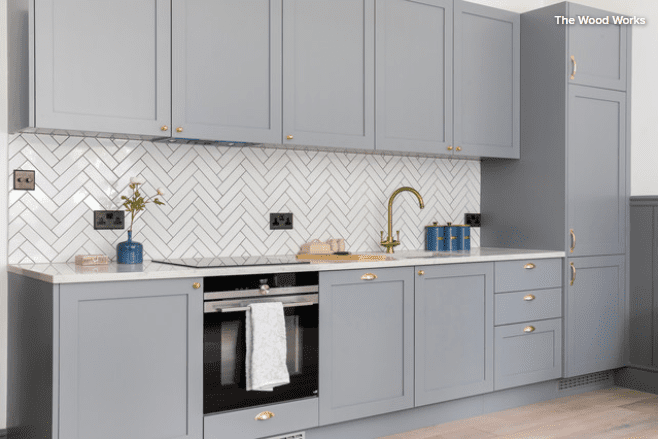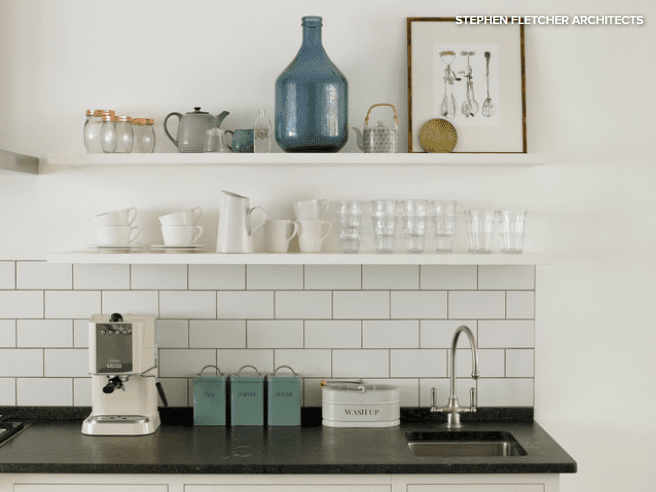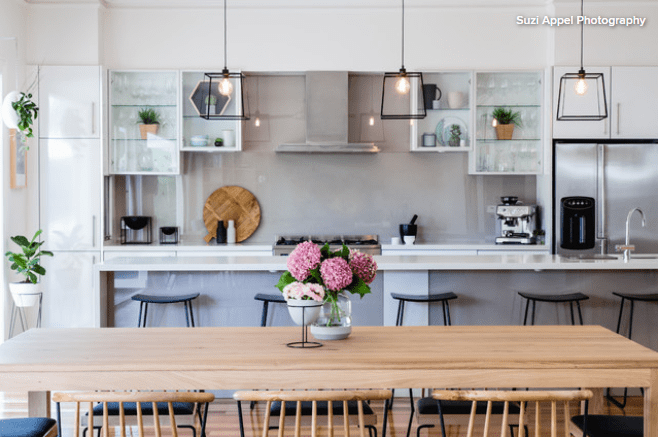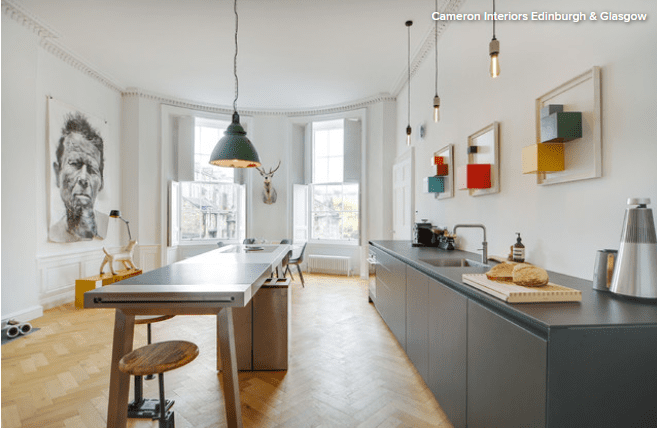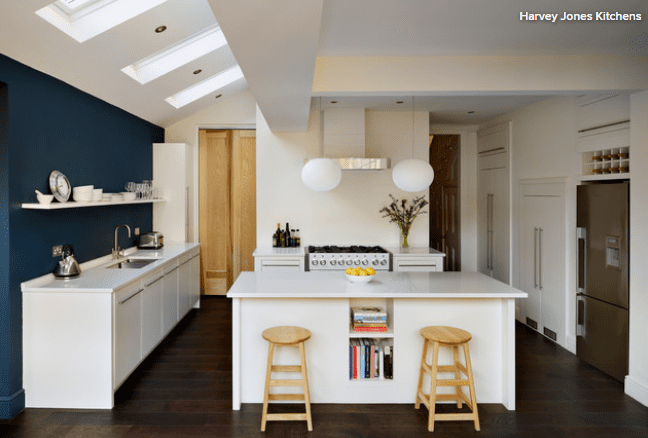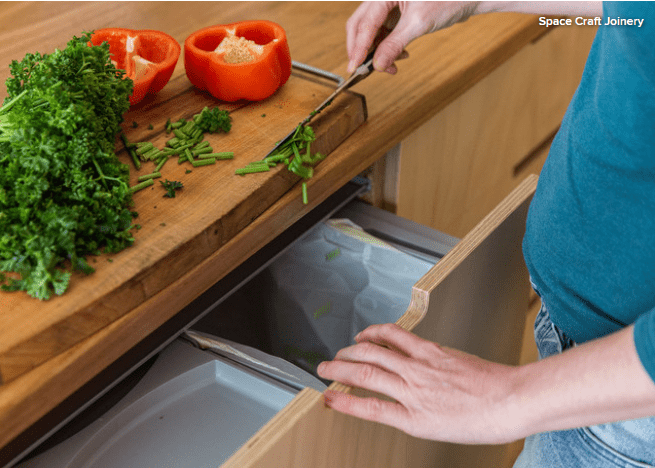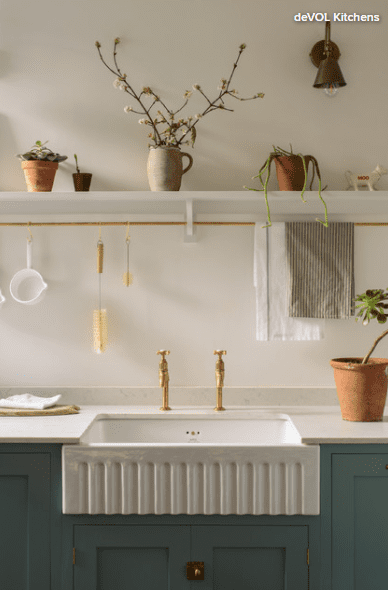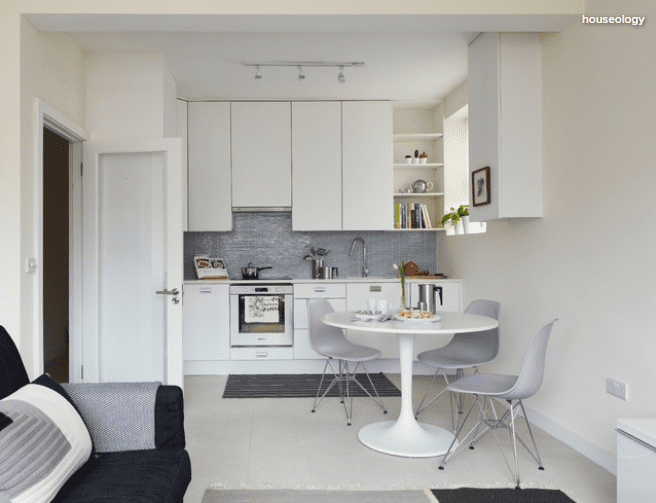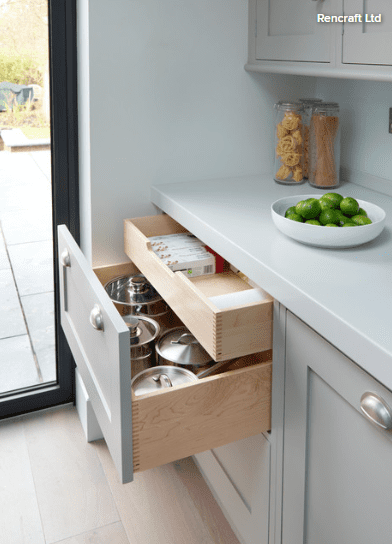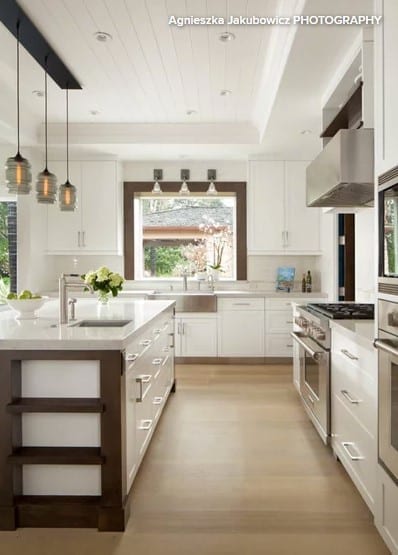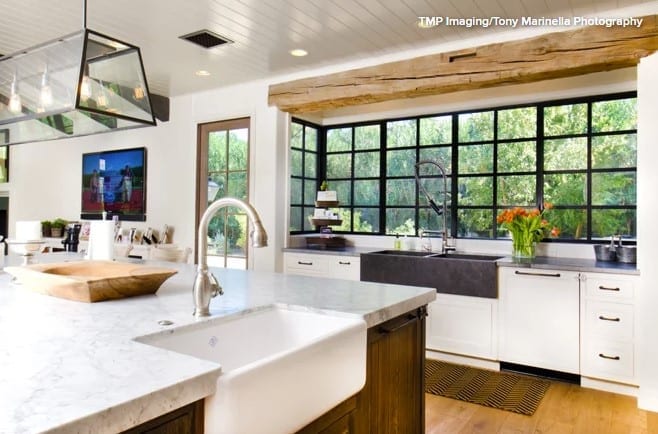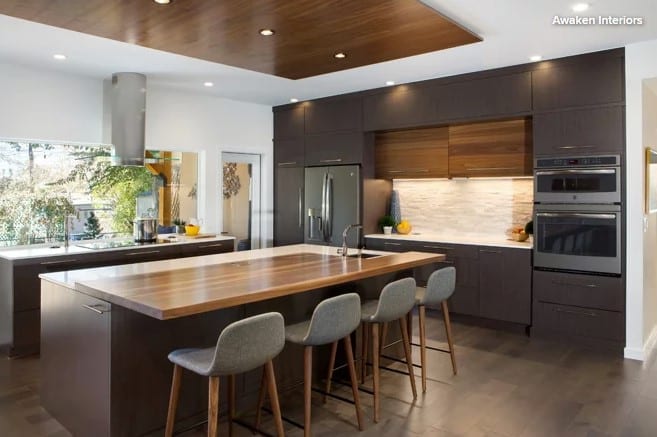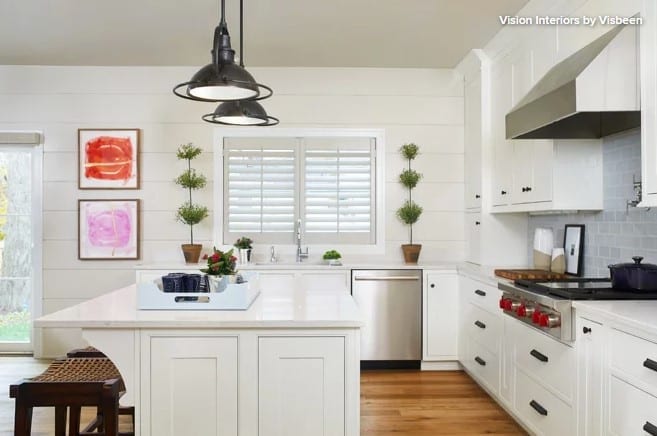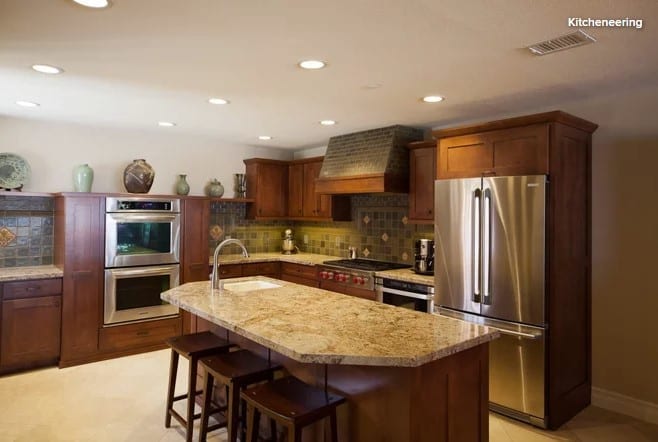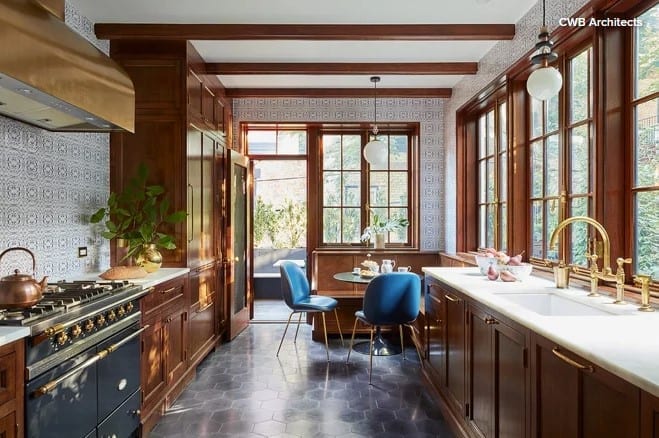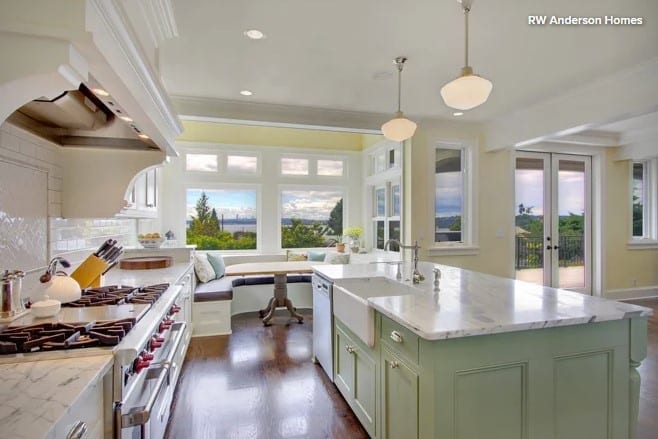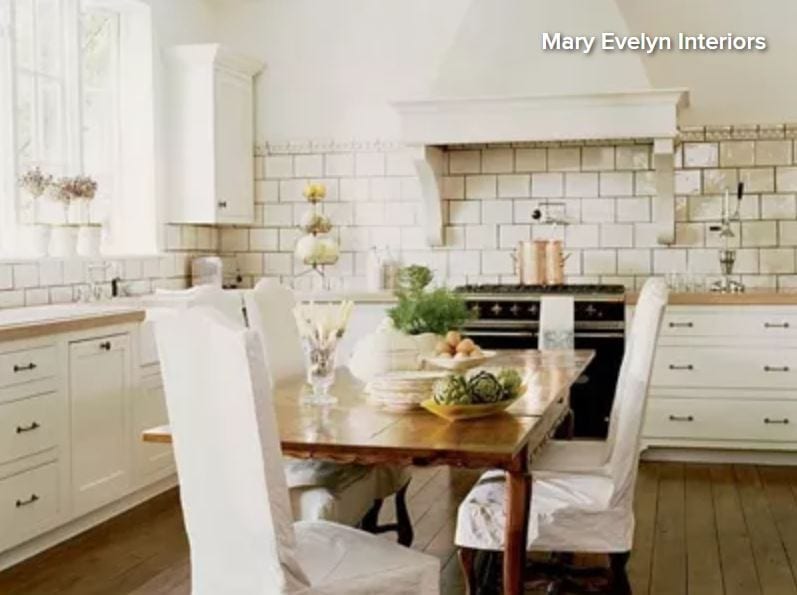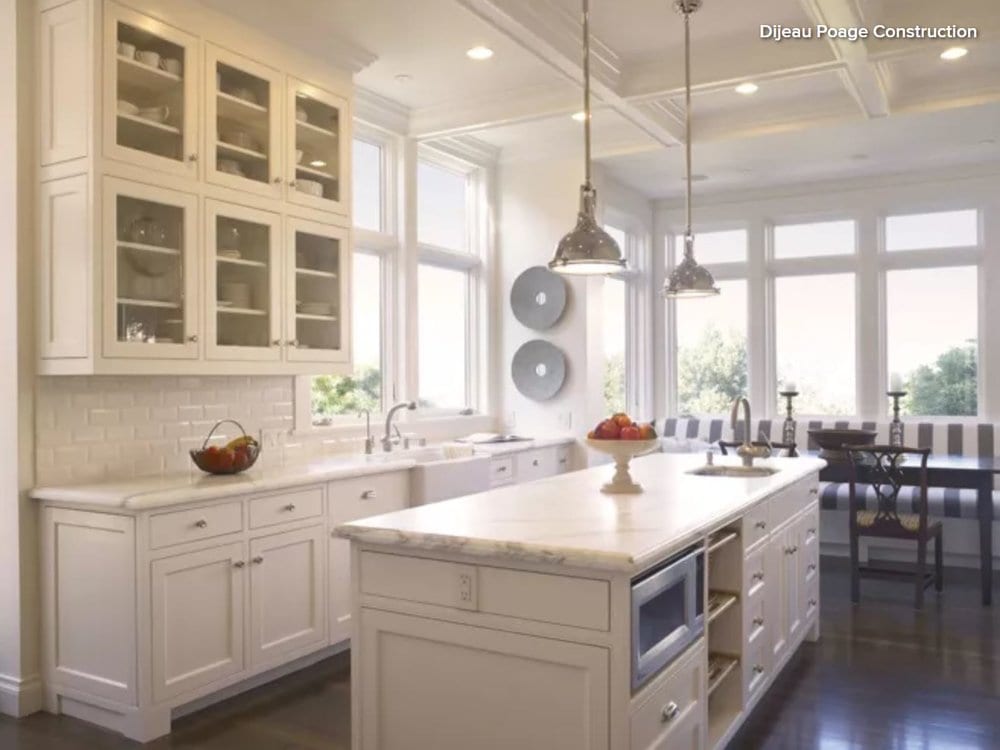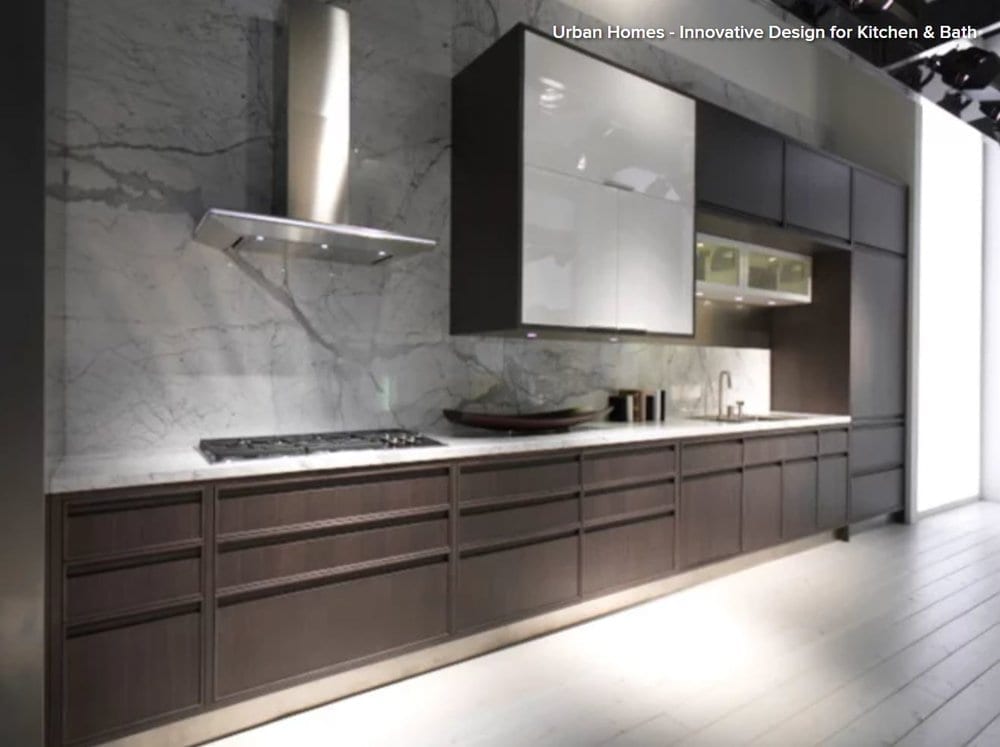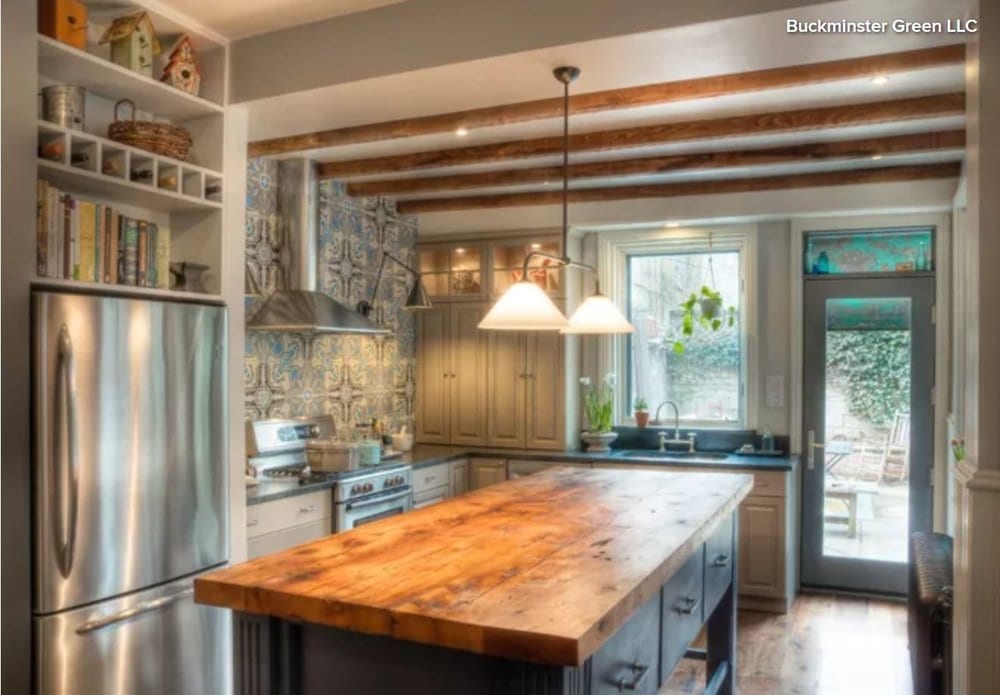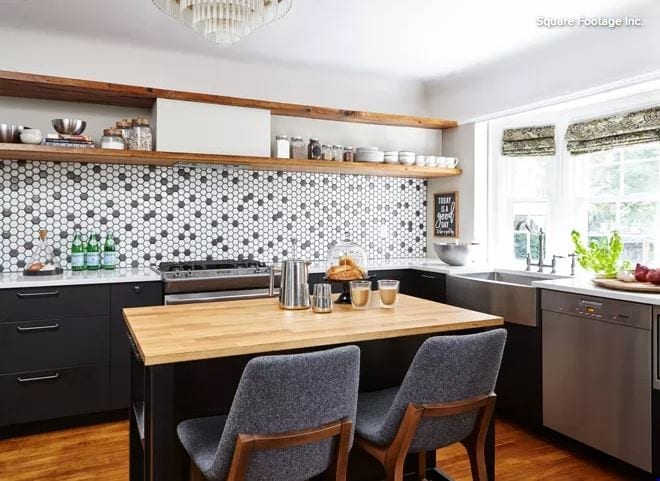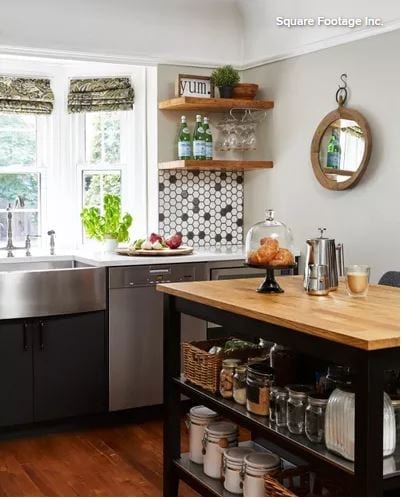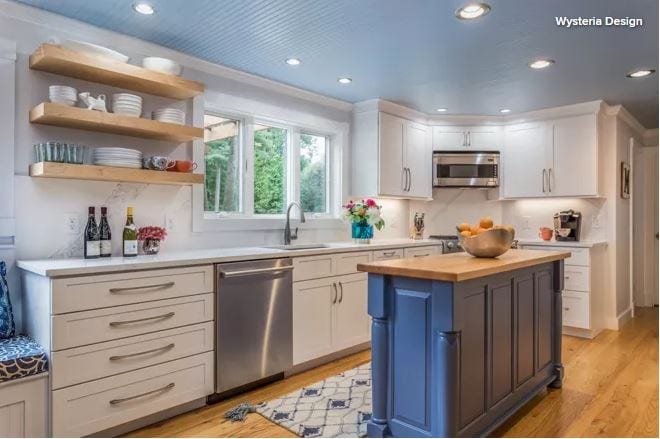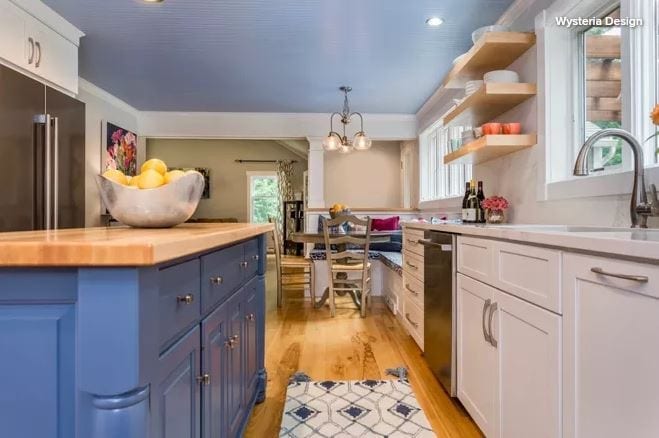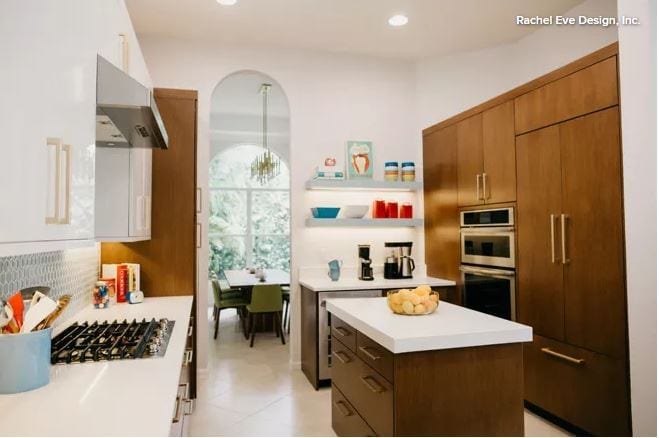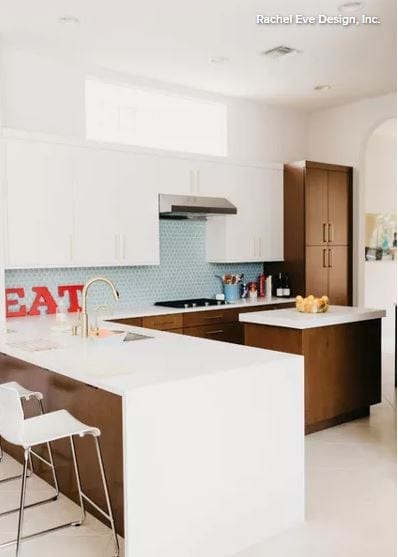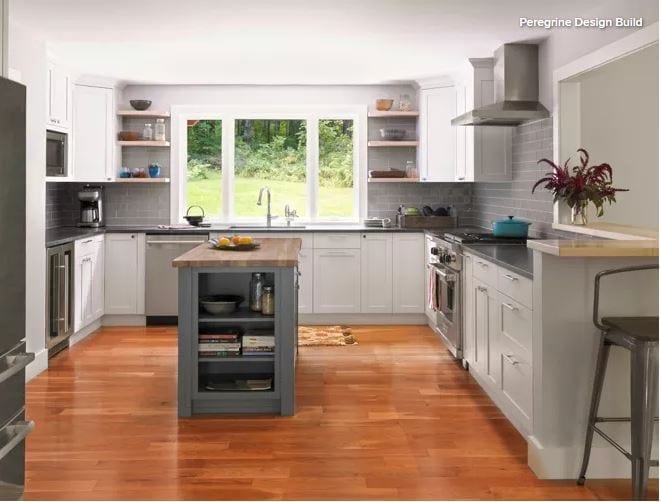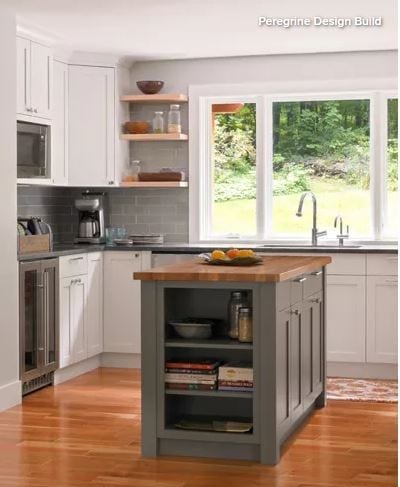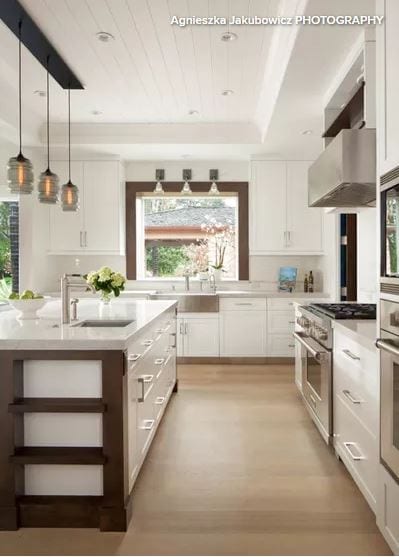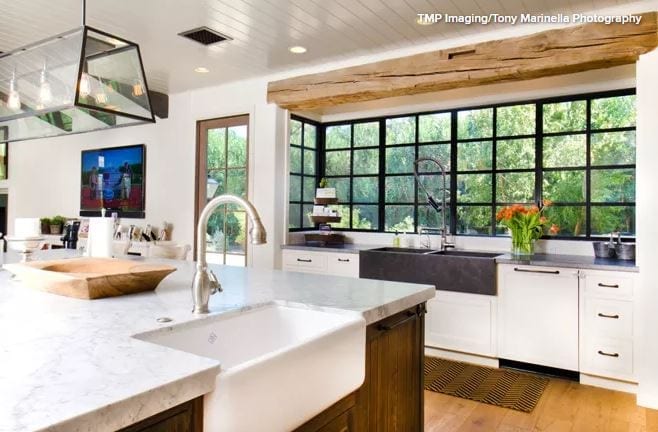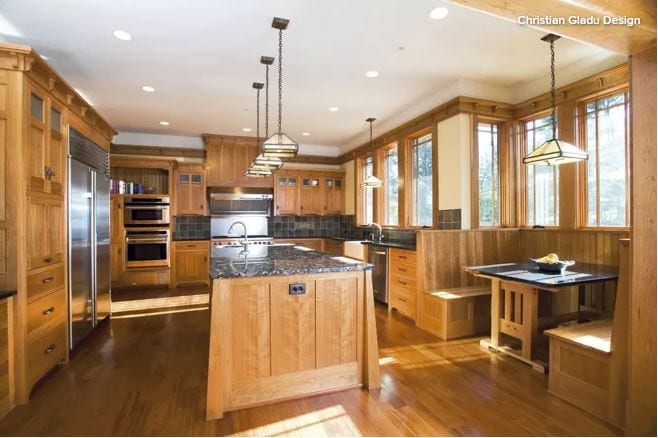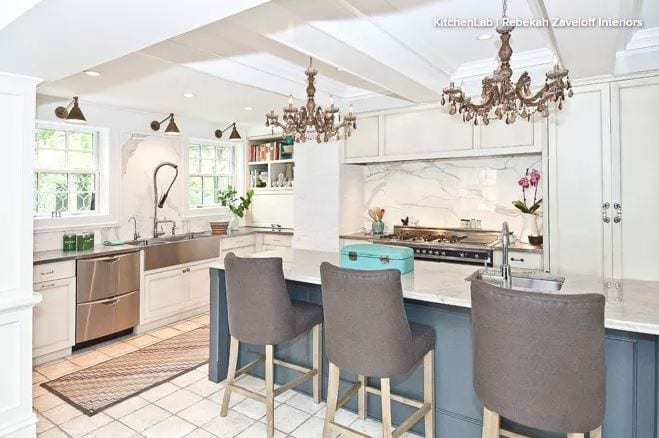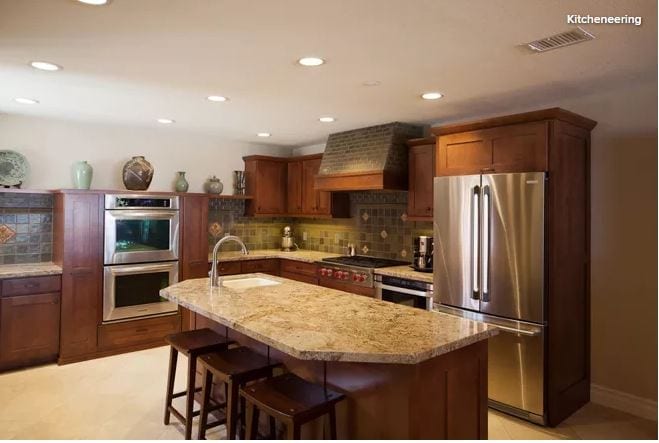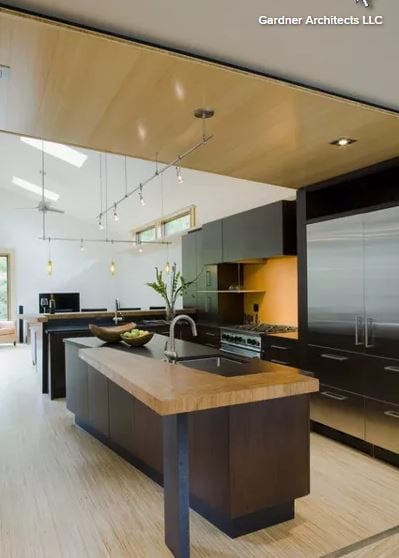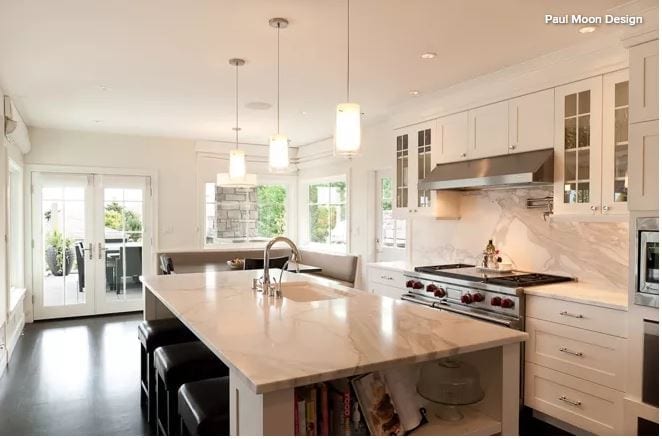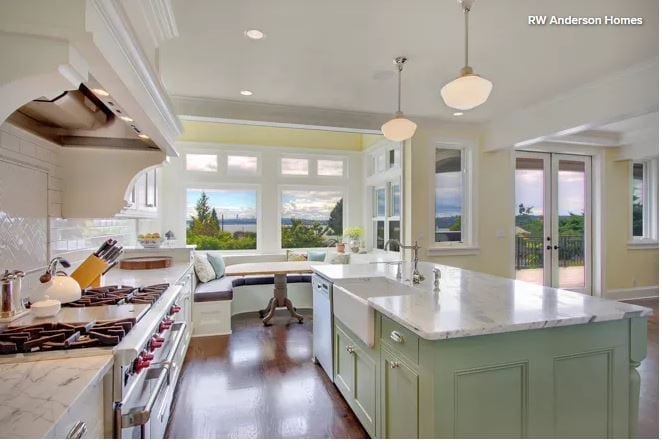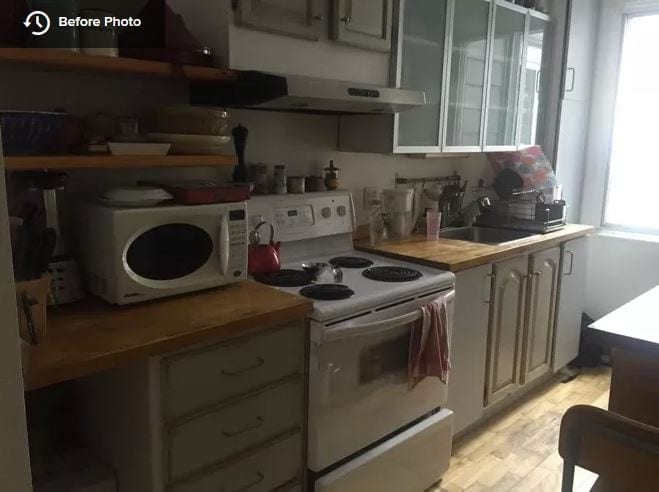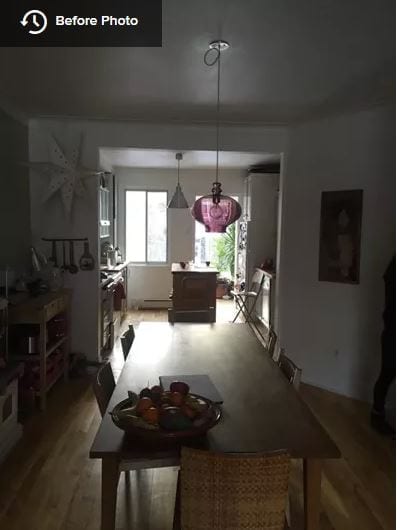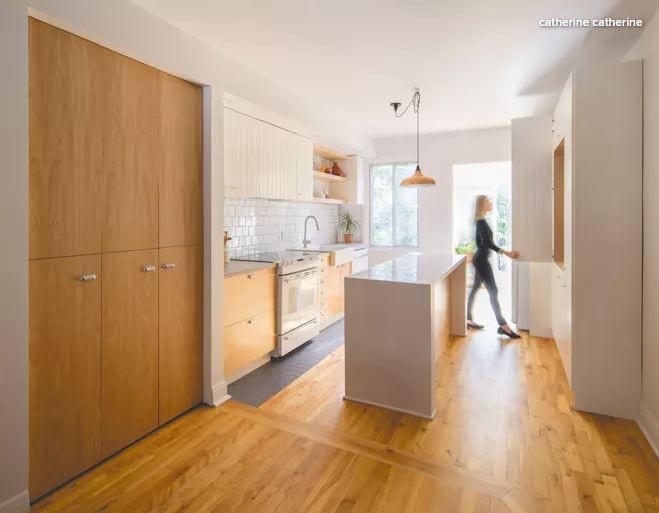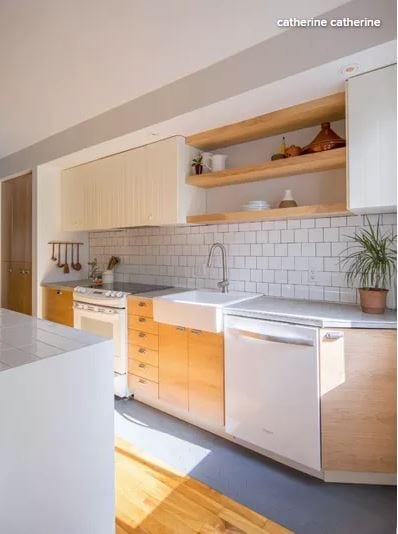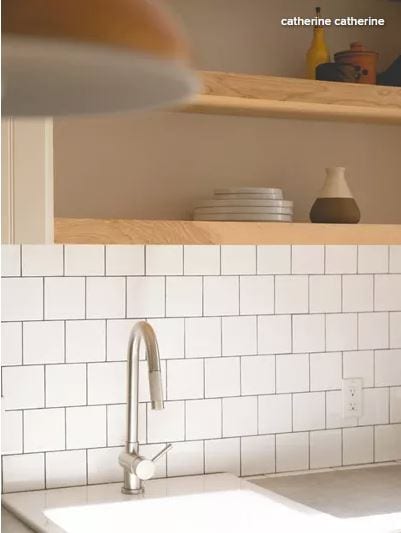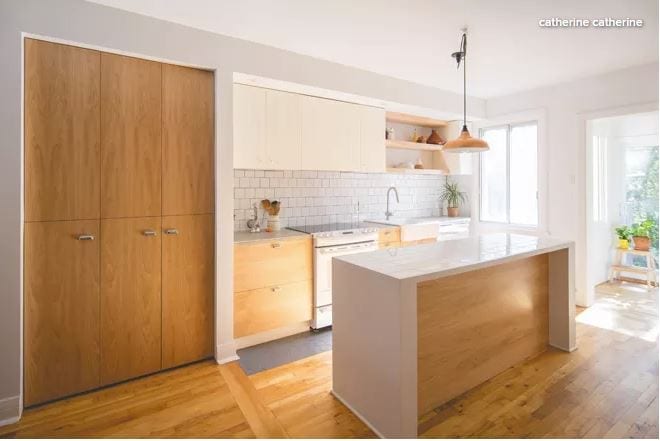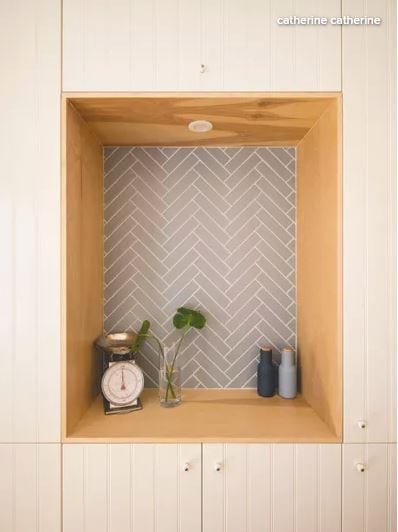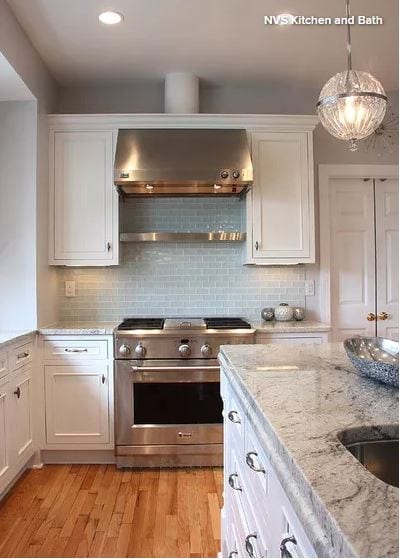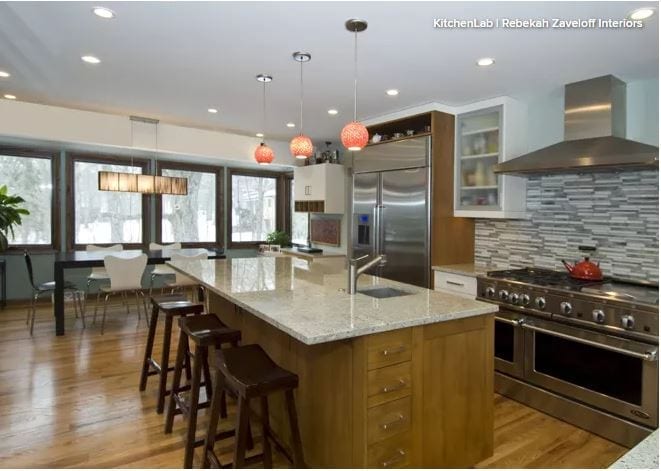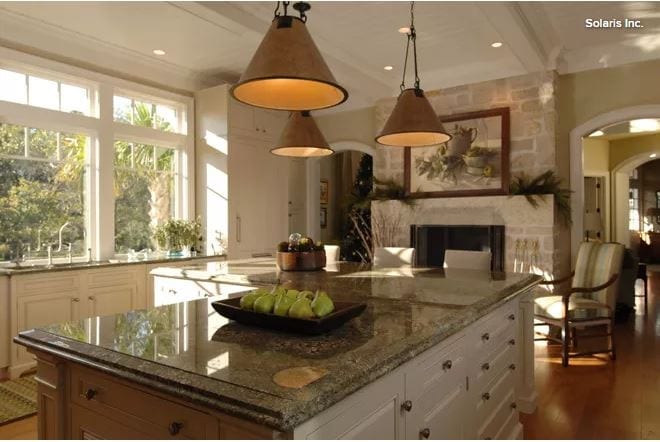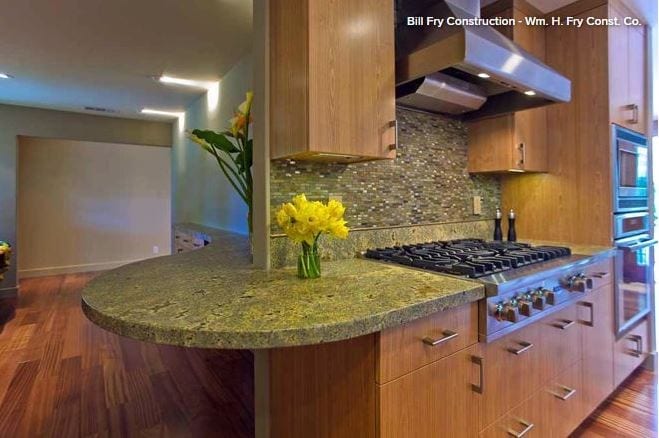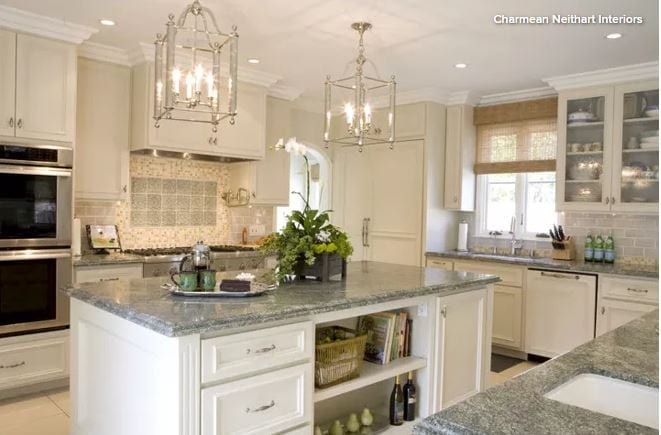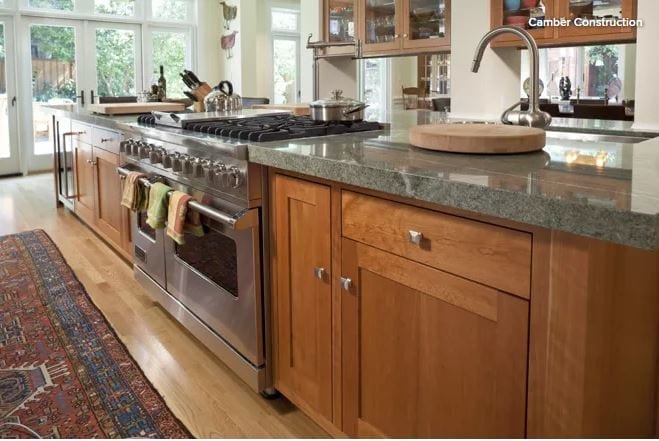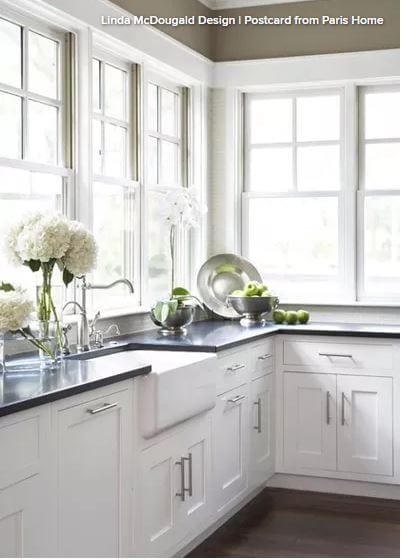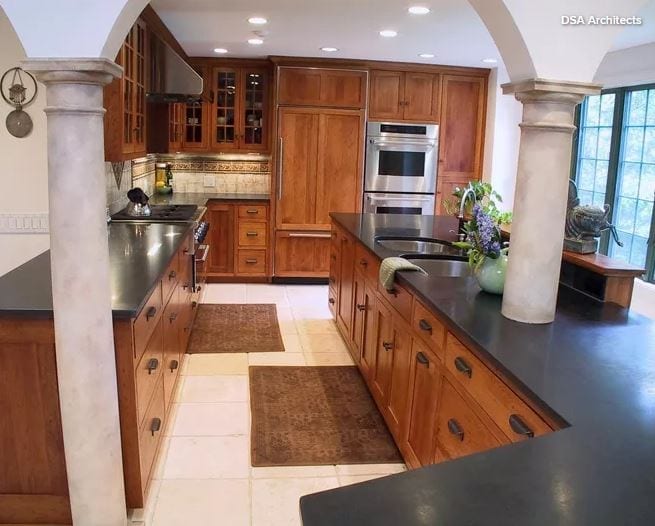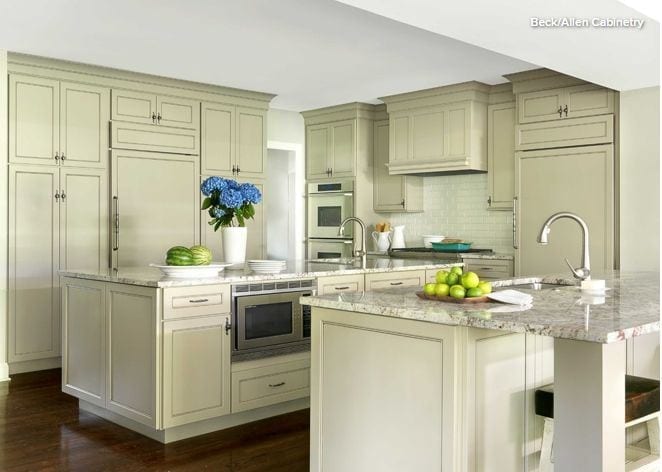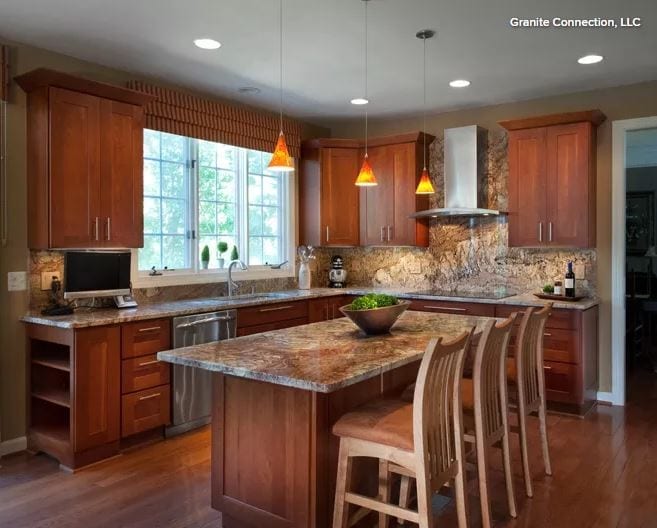
We are proud to support the 2020 St. Jude Dream Home Giveaway!
Last week was the groundbreaking of the new home and soon we’ll be busy inside doing the countertops!
We love giving back to our community and cannot think of a better cause than this!
We are proud to support the 2020 St. Jude Dream Home Giveaway!
Last week was the groundbreaking of the new home and soon we’ll be busy inside doing the countertops!
We love giving back to our community and cannot think of a better cause than this!
The kitchen tends to be the room in our home that needs the most cleaning. The good news is that, with a little planning, you can have a design that makes cleaning a breeze and allows you to spend less time mopping and more time enjoying your space. Check out these expert tips from Eva Byrne of Houseology; Nicolle Whyte, designer at Harvey Jones; and Louise Delaney, design manager at Cameron Interiors.
Buy Easy-Clean Appliances
It’s understandable to be dazzled by the performance or look of a smart new kitchen appliance, but Byrne suggests that you also consider potential purchases with a view to keeping them clean. “Choose a [range] that’s fuss-free and easy to wipe down without needing any exotic lotions or solutions,” she says. “Have a good look at details, such as the knobs on your oven, to make sure there are no hard-to-get-at nooks. Knobs that are too close together mean you can’t get a cloth between them, for example.”
Whyte agrees and suggests choosing an induction cooktop, “as it’s flat, easy and safe to clean.” Furthermore, Delaney says, induction cooktops save you from having to clean the grates and other parts found on gas cooktops.
“We recommend choosing appliances with cleaning programs included,” Delaney says. “Let your appliance do the cleaning for you!” She suggests choosing ovens with pyrolytic cleaning functions (which heat the oven to high temperatures to burn off residue), steam ovens with automatic steam cleaning and drying programs, and coffee machines with automatic cleaning.
Pick a Simple Backsplash
Tile is a popular choice for a kitchen backsplash, but if you don’t want to spend time scrubbing grout to keep it sparkling clean, there are other options.
If you’re set on tile, pick a large-format style to minimize the amount of grout you have to clean. If you choose a glass backsplash, you won’t have to deal with grout at all, Whyte points out.
Favor Flat-Front Cabinets
“Selecting smooth furniture fronts prevents cooking residue forming on decorative grooves and ridges,” Delaney says. Watch out for cutout pulls, though, since they can harbor crumbs.
Choose Your Countertop Material Wisely
“Select materials such as Corian, quartz, steel or sintered stone [mineral and stone particles bound together with heat and pressure], which are nonporous, prevent stains and are easy to wipe clean,” Delaney says.
“Solid-surface [countertops], such as Corian, are probably the most hygienic,” Whyte says. “They have a seamless finish and therefore don’t have grooves to trap dirt. This is why you see them used in hospitals and fast-food chains.”
Position Bins Strategically
Where’s the best place in your kitchen for the trash and recycling bins? To ensure that cleaning up is as efficient as possible, they should be beneath the sink, Byrne says. The goal, she says, is to create “minimum distance between sink and bins, which means minimum opportunities for spills and mess.”
Use Durable Paint
If you have painted walls in your kitchen, you’ll need to wipe them down more often than the walls in other rooms. Choosing a hardwearing paint finish will make this job easier.
“Use an oil-based eggshell [finish], as you can easily wipe this clean without damaging the paint,” Whyte says.
Avoid Open Shelves
Open shelves may look attractive when beautifully styled, but they can be a high-maintenance cleaning option if you have to move dishes, books and decorative objects just to run a duster over the surface.
For a fuss-free kitchen design, Byrne recommends avoiding open shelves “that gather dust and grime” and springing for wall cabinets instead. For this kitchen, she chose a run of sleek uppers, with just one small shelving unit at the right for displaying a few easy-to-dust items.
Use Drawer and Shelf Liners
Drawers can be a bit of a minefield to keep tidy, with crumbs and dust sifting down to settle at the bottom. To keep on top of this, Byrne suggests lining drawers and shelves “with wipeable liner material, cut to size, to prolong the life of your units.”
Whyte agrees and suggests choosing “a melamine finish on the inside of cabinets, as it doesn’t absorb spillages as oak or walnut would.”
It would be great to have an unlimited budget for a kitchen renovation. But the fact is most of us do not. And that’s OK. Compromises of one form or another are part of the process, even for the rare homeowner who enjoys a bottomless budget and expansive square footage.
But how, exactly, do you decide between two compelling options with different pros and cons? The most critical tool to have on hand to help you make tough choices is a clear picture of your remodel goals. To get clarity on what matters most to you, read about some key trade-offs you and your kitchen designer will consider during your project.
How Will You Use Your Kitchen?
When planning a kitchen remodel, you want to be very clear on how you want to use your new kitchen. Here is one example: I want to have people over more often. I want to feel relaxed when I entertain. In order to feel relaxed, I need to make sure that no one is in my way while I cook. I also want my kitchen to stay neat during the cooking process and be laid out so that cleaning up will be efficient.
Clear goals can help homeowners make decisions and, as the budget nears its limit, ultimately choose the options that will best support their goals. What matters most to you in a kitchen?
1. Daily Use vs. Special Events
This area of consideration has to do with how many people your kitchen will serve. From refrigerator storage to seats at the dining table, the number of people you want to accommodate will affect your design choices. You’ll want to consider not only how many people live in the home now, but — if this is your forever home — how many will live in it 10 years from now. Also, how often do you entertain and for how many people?
I had a client who was retired and cooked only for herself and her husband most days. She entertained just four times a year, on holidays. At first, I was a bit baffled by her choice of a 36-inch range, double ovens and a 48-inch-wide refrigerator. But for her, these choices made sense.
As the matriarch of a large family, on those four holidays she cooked for 25 to 30 people and had at least two or three people helping her in the kitchen. It was important to her that we designed a flexible space that worked just as well when cooking for two as for 30.
That approach is a good one: Whenever possible, I recommend that clients design with their maximum capacity needs in mind.
2. Cost vs. Value
As you may have discovered if you’re considering a remodel (or in the midst of one), everything from cabinets to sinks to appliances comes at a variety of price points. How do you decide when it’s worth it to splurge for a high-quality item and when it’s best to save your dollars? Here are some questions to ask yourself:
Will the investment improve your everyday life?
Will the product solve a pet peeve?
Will the addition of this element make your house feel like a home?
Will the purchase increase the value of your home?
In each of these cases, you may decide that the cost of a feature for your new kitchen is worth it because of the value it brings. For example, a better dishwasher might eliminate the need to prerinse dishes.
Perhaps you hate scrubbing dishes, can afford an upgrade and would cherish any minute of spare time away from the sink. Or perhaps you feel quite the opposite: You don’t mind scrubbing dishes at all, and this investment wouldn’t be worth the pennies spent.
Framing your choices as cost vs. value — in terms of your experience in your kitchen, and possibly the resale value of your home — can help you get clarity on what’s worth the extra money.
One helpful way to prioritize your desires is to analyze the frequency and duration of a given task. Tasks you do frequently or spend more time on should get more weight as you consider what is worth investing in.
For example, most people use the burners to cook 80 percent of the time, the oven 20 percent of the time. If this applies to you, I recommend prioritizing the cooktop as opposed to the wall oven, both in terms of placement in your kitchen and quality of product. You wouldn’t want to give up a great burner feature to get a fancier oven.
On the other hand, if you are a frequent baker but rarely use the stovetop, you may prefer to invest in wall ovens rather than spend your budget on a fancy range. For you, it would be better to make sure that reaching into the oven is more ergonomic — done while standing upright, rather than bending over.
3. Function vs. Aesthetics
Ideally a kitchen redesign brings both beauty and function, but when we are dealing with limited funds, trade-offs between functionality and aesthetics may be necessary. By function, I mean not only the kinds of bells and whistles you get with high-end appliances, but also the kitchen’s layout and the choice of whether to have one sink or two.
Aesthetics, of course, are the expensive but gorgeous finishes and customized detailing that bring a high-end look to a kitchen. Quite often, a budget may force you to make choices on what matters most to you — the functionality or the look.
This area of trade-off is deeply personal and has a lot to do with your lifestyle. When weighing aesthetics vs. function, you’ll want to consider everything I mentioned before: how many people you cook for daily, how often you entertain, the kind of entertaining you do (backyard barbecues vs. sit-down dinners), the style of cooking you prefer and how many people work in the kitchen at one time.
For example, a client who doesn’t do a lot of cooking and is more concerned with the kitchen’s look than its function might really want a beautiful built-in fridge with custom panels but be willing to use a less expensive range or counter material to have that pricey, beautiful fridge.
On the other hand, I have had several clients (including the owners of the kitchen in this photo) who chose a free-standing fridge and put their budget into the plumbing and construction work required to add a second sink. To me, this is a significant functional improvement and, for those who enjoy cooking and entertaining, worth scaling back on some of the aesthetic details.
There are many ways you can cut back on aesthetics to create room in your budget for what’s important to you functionally. You might consider a simpler, less expensive door style on the cabinets, or a ceramic backsplash tile instead of glass, or quartz counters instead of granite.
I even had one client use a very inexpensive laminate counter so that she could put more money into the remodel work necessary to get the layout just right. Since she was in her forever home, she replaced the laminate with a beautiful stone two years later when finances allowed.
4. Speed vs. Patience
Any home improvement project takes time — that’s just part of the process. And once the kitchen is demolished and construction is underway, any delay can be difficult, particularly if you are living in the home and dealing with the mess. When you are in that situation, the risk is that you will be tempted to say yes to anything just to get the project done and your home back to normal.
This happened with one of my clients, who decided to use a second-choice backsplash because it was in stock, whereas her first choice had a month lead time. On the other hand, a different client had trouble finding a backsplash tile she liked, so she finished her kitchen and skipped the backsplash altogether. Three months later, she found the perfect tile and brought the tile installer back. I am sure you can guess which homeowner was more happy with her kitchen remodel.
When making a large financial investment that you are going to live with a long time, I recommend that you go slowly, taking the time to find the right people to help and weighing your decisions carefully.
That being said, speed can be a necessary evil. Perhaps you are remodeling for a special event, such as a backyard wedding. Or maybe you are planning to sell the house and just want a quick face-lift to get the most out of your investment.
As a guide when weighing the need for speed vs. the need to exercise your patience muscles, I recommend you consider how long you plan to live in your home. If you’re going to sell within five years, keep in mind that everything doesn’t have to be perfect — you simply want to be sure you will get your investment back when you sell. However, if you plan to live in the home for 10 years or more, it’s worth slowing down and investing in your quality of life. Take the time to find the right solution, not the quick one.
5. The Ideal Me vs. the Real Me
This one isn’t so much a trade-off as a reality check. It’s worth mentioning that some clients have fantasies that a remodel can change their habits — or even their personalities. But my observation has been that if you are already a messy cook, the chances of a new kitchen transforming you into a clean-as-you-go type are pretty slim.
Rather than plan a kitchen for the person you wish you were, focus on solutions that take your true habits into account. For example, a messy cook who is embarrassed when guests are around might want to add a separate cleanup sink where he can hide dirty dishes while making a meal.
Or, if clutter is a constant problem, a homeowner might want to create a hidden drop zone for papers, cellphones, pens and other detritus that kitchen counters tend to attract.
Article by Amanda Pollard
Dark and dramatic or light and bright? When it comes to choosing kitchen cabinets, it can be hard to decide. Here we look at the benefits of crossing over to the dark side.
1. Add Ambiance
If you’re looking to design a kitchen that’s both contemporary and cozy, dark cabinets could be the way to go. Inky surfaces, like the ones in this elegant kitchen, help enclose the space slightly to create an intimate feel.
Position your lighting strategically, so it casts an atmospheric glow over the dark finishes.
2. Bump Up the Style
For a dose of sophistication, you can’t beat dark cabinetry. Moody colors give a grown-up feel that can make a space feel seriously chic.
In this kitchen, the classic white wall tiles and the pale gray flooring highlight the dark gray cabinets and the black architectural features beautifully. Brass handles, meanwhile, bring out the richness of the charcoal hue.
3. Hide the Knocks
All kitchens get their fair share of wear and tear, but some show it less than others. A kitchen with dark cabinets, such as this one by Compass & Rose, is a good choice if you think your cabinets are going to need to stand up to frequent spillages and dings.
A dark surface can be more forgiving than a light one and won’t instantly show scuffs and stains. If you’re painting your cabinets, make sure you apply a few coats, so the dark undercoats hide any scratches in the topcoat.
4. Contrast With White
If you’re going for a white countertop, contrasting it with a dark shade will have the most striking effect. The gleaming marbled surface here looks stunning against the deep-hued cabinets. The House of Beulah designers embraced the contrast, mixing white walls with dark gray features. To warm up the room, they added a wooden floor and some soft foliage.
5. Highlight Bold Colors
Just as dark cabinets set off a white countertop, they also can form a dramatic backdrop for other vivid colors. Take a look at this kitchen designed by Roundhouse, for example. The dark gray cabinets are neat and practical, but it’s the accents of green and red that really make the space. The cabinetry works as a moody canvas to showcase those bright bursts of color.
6. Embrace Luxury
Dark colors look beautiful with metallic finishes, such as brass and copper, as this space by Naked Kitchens illustrates. The green cabinets complement, rather than clash with, the brass faucet and backsplash.
The two surfaces are wonderfully balanced, giving this room a feeling of understated luxury.
7. Zone the Space
In an open plan, it’s a good idea to use color to zone different areas. By using a dark shade on your cabinets, you can make your kitchen appear grounded in its spot.
The dark cabinets in this kitchen by Hannah Gooch contrast with the white walls around them, helpfully marking out the kitchen from the rest of the room.
Tell us: Have you dared to go dark with your kitchen, or do you prefer a lighter color scheme?
You’ve decided to remodel your kitchen. Now what? Not knowing where to start, many homeowners fall into two camps. Some start by looking at appliances. Others start by collecting inspiring kitchen photos. Some decide they need more room. Others simply want to upgrade their current kitchen. Homeowners may find themselves in this exploration stage for a year or longer before they start interviewing kitchen designers or general contractors.
Once you’ve pondered long enough and you’re ready to green-light a kitchen remodeling project, then what? We’ll start with the first 9 steps and we’ll get into the nitty-gritty details under specific steps as we move through the complete kitchen remodel workbook.
Step 1: Think about what you need in your kitchen remodel
This step is all about how you use your kitchen, and finding the layout and features that fit your household’s lifestyle.
Think about your priorities: how many people will be cooking and gathering here, and how they’ll need to move around in it. Do you need an addition? Or can you work with your existing kitchen footprint?
If you haven’t already, start saving photos of kitchens with features that suit your style. Your collection can be organized and beautiful like a scrapbook or it can be filled with random, unorganized images. I actually prefer the latter, because I like to randomly stuff images into my folders and ideabooks and go back to them later on for edits.
Step 2: Research and plan
Ready to green-light that project and take the plunge? The best place to start is by formulating what’s commonly referred to as a scope of work and figuring out your preliminary budget.
Both of these may be subject to change, so don’t feel like you have only once chance at this. Budget and scope are intertwined and often change many times during the kitchen design process as you become more educated and able to reconcile what you want and what you can afford. As a homeowner, you’re not expected to walk into this knowing what everything should cost. Remember, this is an educational process.
Step 3: Find the professionals you will need
Even if you’re going the DIY route, unless you’re building your own kitchen cabinets and doing your own electrical and plumbing, you’re going to have to work with a professional at some point. It may be as brief as leaning on your salesperson to help you in selecting and ordering your appliances or cabinets, but it’s something to plan on either way.
Some people start by visiting big-box stores or cabinet showrooms where they can see everything. Many homeowners get referrals from friends or colleagues and start by hiring an architect or designer. Still others might work on their own with a builder or contractor. Pros are available to help you with everything from contracts and permits to space planning, budgets, choosing finishes and fixtures, shopping, ordering products, helping you set up a temporary kitchen, and managing your project from start to finish.
Step 4: Schematic design
This phase includes sketches, space planning, preliminary floor plans and elevations showing the layout and cabinet sizes. I try to keep my clients focused more on layout and space planning, even though the temptation is to talk about what the kitchen will look like. But I find that getting caught up in the look too early can distract from the space planning phase.
Plus, you need a plan in order to figure out what materials will go where, and how many square feet you will need, and ultimately how much this will cost. I like to begin the contractor interview process early and give them a preliminary drawing packet and scope of work so we can get some ballpark construction numbers. At the same time you can be sending out drawings for estimates on some top choices of kitchen finishes and fixtures.
Step 5: Fixture and finish specification
Throughout this process, and probably long before, you have been saving photos of kitchens you love into your ideabooks and folders. You’ve found your kitchen style, whether it’s modern, classic, traditional, cottage or a personal style in between. You probably know if you want a white kitchen, a natural wood kitchen, or some color.
Now you need to make your final selection of finishes and fixtures. This usually includes:
Cabinetry construction type, doorstyle, finish and color
Countertop material
Refrigerators and other appliances
Kitchen sink and faucet
Light fixtures
Flooring
Backsplash
Decorative hardware
Step 6: Work on design development and construction documents
This is the stage when you finalize the design and prepare final floor plans, elevations, details and, if applicable, mechanical and electrical drawings, lighting switch plans, and exterior elevations.
This is where your final permit set or Construction Drawings (CDs) come into play. It’s important to have finishes and fixtures selected at this time, since this is what will be considered in the final pricing from the contractor.
You’ll submit drawings for permits. These have a lead time, so check the timing with your local village. You’ll need an architect, designer or licensed contractor signed up to finalize the paperwork and pick up your permits, so get ready to hire someone in the next step. I often find that we’re submitting for permits around the same time or a little bit after we’ve placed the cabinet order, due to similar lead times.
Step 7: Get contractor estimates
If you don’t already have a licensed contractor on your project, your next step is to find one to carry the project through. I always recommend to my clients to get at least three different contractor estimates. I like to do preliminary walk-throughs with the contractors once the schematic designs are done so we can get some ballpark estimates and find out if we’re on the right track or need to pull back some to fit the budget.
Step 8: Get ready for demo
The big day is upon us, most likely something like 4-8 weeks from when you submitted for permits. Time to get that schedule firmed up and plan on cleaning out the cabinets, putting what you don’t need in storage and — if you’re living in the house during construction — setting up a temporary kitchen so you don’t lose your mind!
You may be moving out of your house temporarily, but most homeowners white-knuckle it and try to live in the house through construction. Preparation and organization can save your sanity.
Discuss the logistics ahead of time with your contractor. Will you meet once a week for updates? Will you have to be out of the house for certain tasks like demo or flooring? What about debris removal and dust? Are there any family allergy issues? What is a typical work day for the crew? Getting all this on the table beforehand can set expectations and make for a smoother ride.
Step 9: Surviving the dreaded punch list
Once construction is over, well … almost over … there’s always this annoying little list of items that are missing, wrong, or simply forgotten about. A missing light switch plate, a caulk line that shrank and pulled away from the wall, paint touch ups — small things like this, and sometimes bigger things like the hood doesn’t work, or there’s a big scratch in the newly refinished floor.
Sometimes the homeowner does the punch list. It can be as informal as an emailed list of items that need to be fixed or finished. I like to use a little form I put together that identifies the item to be fixed or finished, the responsible party and the date of completion. I send it to the client for review, changes and additions, and then off to the contractor.
It’s inevitable that the contractor may have to make multiple visits back to the house to finish these items; prepare yourself for more than one visit and you’ll be fine. The best way to approach this is with a Zen attitude. Things happen, little things get missed. It’s sort of like making a list for the grocery store and still forgetting some key ingredient. We all do it.
Article by: Mitchell Parker
1. Little Black Box
Designer: Frankie Castro of Square Footage
Location: Ajax, Ontario
Size: 160 square feet (15 square meters); 16 by 10 feet
Homeowners’ request. Bring a 120-year-old kitchen into the 21st century while honoring original details like the cove ceiling, wood flooring, chandelier and molding details.
Island. 2 by 4 feet, painted black, with a wood top and stainless steel shelves. “It married all the features in this kitchen together,” says designer Frankie Castro, who gained ideas and inspiration by browsing photos on Houzz along with her clients.
Other special features. Backsplash of white and gray hexagonal mosaic tile. Reclaimed-wood open shelves. Black base cabinets. Quartz countertops.
Designer secret. “The trick is to keep the vintage feeling and details,” Castro says. “In this kitchen we only went up to the molding line, which featured the cove ceiling prominently. We also kept with the plaster walls and were very careful when cutting or replacing the walls.”
Wall paint: Distant Gray, Benjamin Moore
2. Slim Style
Designer: Becky Corringham of Wysteria Design
Location: Stratham, New Hampshire
Size: 220 square feet (20 square meters); 11 by 20 feet
Homeowners’ request. Remove and replace existing dark cherry cabinets, black countertops and a black painted island. The owners found designer Becky Corringham through Houzz’s directory, and they used the site to collaborate on an ideabook of inspirational photos, through which they also bought products like the floating maple shelves and chandelier.
Island. 5 feet, 2 inches by 1½ feet with a maple wood base painted blue (Denim by Sherwin-Williams) and a solid butcher-block top. “The homeowners use their island for storing large items like their crockpot, blender, coffee grinder and indoor grill,” Corringham says. “The drawers of the island are used for small miscellaneous utilitarian items, such as pens, paper, scissors and tools.”
“In the design phase of this project we thought about adding a peninsula instead of an island, because the space in that area is very narrow. The width of the kitchen is about 9½ feet, and the traffic flows past the island leading into the first-floor half bath and laundry room, so we didn’t want to impede the walk space too much. We really liked the idea of keeping the custom bench seating, so that is what ultimately determined the need for an island over a peninsula.”
Other special features. Quartz perimeter countertops and backsplash with a Calacatta marble look. Light blue ceiling (Honest Blue by Sherwin-Williams).
3. Sweet Station
Designer: Rachel Eve Logue of Rachel Eve Design
Location: Palm Beach Gardens, Florida
Size: 140 square feet (13 square meters); 14 by 10 feet
Homeowners’ request. Update a basic, traditional kitchen to reflect a more midcentury modern style within the existing footprint.
Island. 2 by 4 feet with a rift-cut oak veneer base and 2-inch-thick white quartz countertop. “We made the countertop on the island thicker than the perimeter to give the island more emphasis so it didn’t look so puny,” designer Rachel Eve Logue says. The island has two small top drawers and two deep bottom drawers — plenty of space to store utensils for baking, which the homeowners love to do.
A 2-by-2-½-foot island existed in the same space before, but because the floor tile didn’t go underneath it, and because the homeowners didn’t want to hassle with replacing the flooring, they decided to keep an island in that spot and increase its size.
Other special features. Aqua hexagonal tile backsplash and aqua floating shelves. Peninsula with white quartz waterfall-edge detail. Paneled refrigerator and tall pantry. The homeowners had originally thought they wanted all-white cabinets, but when Logue looked through their Houzz ideabook of inspiration photos they had gathered, she noticed that they had saved a lot of kitchens with dark base cabinets and white upper cabinets. She suggested they go that route and include white countertops, to lighten the kitchen but still have that dark wood, midcentury modern vibe.
Designer secret. The previous backsplash was composed of glass blocks that matched the transom above the range. The glass let in light, but the view to the neighbors’ hedge wasn’t something the owners wanted to hang on to. To get a stylish backsplash, Logue drywalled directly over the glass blocks (they are still visible from the exterior) and covered the drywall with the statement tile. “If we had left the blocks, we just wouldn’t have gotten the same impact in this kitchen,” she says.
4. Neat and Narrow
Designer: Cliff Deetjen of Peregrine Design Build
Location: Richmond, Vermont
Size: 250 square feet (23 square meters)
Homeowners’ request. A more light-filled kitchen with new custom cabinets and a better connection to the surrounding areas.
Island. About 2 by 5 feet with a hard maple countertop and painted gray base (Smoke Gray by Benjamin Moore), a color choice that designer Cliff Deetjen says is smart for an active family. “The clients were intent on repurposing their rolling butcher-block island,” Deetjen says. “We convinced them that it was worth the investment to have a custom island built. Not only was it aesthetically appealing, it also offered them additional storage and an efficient place to organize their day. Cookbooks and favorite recipes are stored on the lower shelves. Pots and pans are tucked away on the stove side, and the surface functions as a place to put anything that needs to be grabbed on the way out.”
Other special features. 3-by-9-inch glass tile backsplash. Jet Mist granite countertops. Custom wine fridge. Hidden phone and computer charger in drawer.
Designer secret. “We were excited to use mixed finishes in this project,” Deetjen says. “The island butcher-block counter plays off of the wood in the open shelving and wood counter at the eat-in dining area. Industrial touches are complemented by the warm cherry floors, and even the client’s rustic pottery collection is at home on the dark granite counters.”
Cabinet paint: White Wisp, Benjamin Moore; project photos: Susan Teare
By: Moorea Hoffman
It would be great to have an unlimited budget for a kitchen renovation. But the fact is most of us do not. And that’s OK. Compromises of one form or another are part of the process, even for the rare homeowner who enjoys a bottomless budget and expansive square footage.
But how, exactly, do you decide between two compelling options with different pros and cons? The most critical tool to have on hand to help you make tough choices is a clear picture of your remodel goals. To get clarity on what matters most to you, read about some key trade-offs you and your kitchen designer will consider during your project.
How Will You Use Your Kitchen?
When planning a kitchen remodel yourself or with a kitchen designer, you want to be very clear on how you want to use your new kitchen. Here is one example: I want to have people over more often. I want to feel relaxed when I entertain. In order to feel relaxed, I need to make sure that no one is in my way while I cook. I also want my kitchen to stay neat during the cooking process and be laid out so that cleaning up will be efficient.
Clear goals can help homeowners make decisions and, as the budget nears its limit, ultimately choose the options that will best support their goals. What matters most to you in a kitchen?
1. Daily Use vs. Special Events
This area of consideration has to do with how many people your kitchen will serve. From refrigerator storage to seats at the dining table, the number of people you want to accommodate will affect your design choices. You’ll want to consider not only how many people live in the home now, but — if this is your forever home — how many will live in it 10 years from now. Also, how often do you entertain and for how many people?
I had a client who was retired and cooked only for herself and her husband most days. She entertained just four times a year, on holidays. At first, I was a bit baffled by her choice of a 36-inch range, double ovens and a 48-inch-wide refrigerator. But for her, these choices made sense.
As the matriarch of a large family, on those four holidays she cooked for 25 to 30 people and had at least two or three people helping her in the kitchen. It was important to her that we designed a flexible space that worked just as well when cooking for two as for 30.
That approach is a good one: Whenever possible, I recommend that clients design with their maximum capacity needs in mind.
2. Cost vs. Value
As you may have discovered if you’re considering a remodel (or in the midst of one), everything from cabinets to sinks to appliances comes at a variety of price points. How do you decide when it’s worth it to splurge for a high-quality item and when it’s best to save your dollars? Here are some questions to ask yourself:
Will the investment improve your everyday life?
Will the product solve a pet peeve?
Will the addition of this element make your house feel like a home?
Will the purchase increase the value of your home?
In each of these cases, you may decide that the cost of a feature for your new kitchen is worth it because of the value it brings. For example, a better dishwasher might eliminate the need to prerinse dishes.
Perhaps you hate scrubbing dishes, can afford an upgrade and would cherish any minute of spare time away from the sink. Or perhaps you feel quite the opposite: You don’t mind scrubbing dishes at all, and this investment wouldn’t be worth the pennies spent.
Framing your choices as cost vs. value — in terms of your experience in your kitchen, and possibly the resale value of your home — can help you get clarity on what’s worth the extra money.
One helpful way to prioritize your desires is to analyze the frequency and duration of a given task. Tasks you do frequently or spend more time on should get more weight as you consider what is worth investing in.
For example, most people use the burners to cook 80 percent of the time, the oven 20 percent of the time. If this applies to you, I recommend prioritizing the cooktop as opposed to the wall oven, both in terms of placement in your kitchen and quality of product. You wouldn’t want to give up a great burner feature to get a fancier oven.
On the other hand, if you are a frequent baker but rarely use the stovetop, you may prefer to invest in wall ovens rather than spend your budget on a fancy range. For you, it would be better to make sure that reaching into the oven is more ergonomic — done while standing upright, rather than bending over.
3. Function vs. Aesthetics
Ideally a kitchen redesign brings both beauty and function, but when we are dealing with limited funds, trade-offs between functionality and aesthetics may be necessary. By function, I mean not only the kinds of bells and whistles you get with high-end appliances, but also the kitchen’s layout and the choice of whether to have one sink or two.
Aesthetics, of course, are the expensive but gorgeous finishes and customized detailing that bring a high-end look to a kitchen. Quite often, a budget may force you to make choices on what matters most to you — the functionality or the look.
This area of trade-off is deeply personal and has a lot to do with your lifestyle. When weighing aesthetics vs. function, you’ll want to consider everything I mentioned before: how many people you cook for daily, how often you entertain, the kind of entertaining you do (backyard barbecues vs. sit-down dinners), the style of cooking you prefer and how many people work in the kitchen at one time.
For example, a client who doesn’t do a lot of cooking and is more concerned with the kitchen’s look than its function might really want a beautiful built-in fridge with custom panels but be willing to use a less expensive range or counter material to have that pricey, beautiful fridge.
On the other hand, I have had several clients (including the owners of the kitchen in this photo) who chose a free-standing fridge and put their budget into the plumbing and construction work required to add a second sink. To me, this is a significant functional improvement and, for those who enjoy cooking and entertaining, worth scaling back on some of the aesthetic details.
There are many ways you can cut back on aesthetics to create room in your budget for what’s important to you functionally. You might consider a simpler, less expensive door style on the cabinets, or a ceramic backsplash tile instead of glass, or quartz counters instead of granite.
I even had one client use a very inexpensive laminate counter so that she could put more money into the remodel work necessary to get the layout just right. Since she was in her forever home, she replaced the laminate with a beautiful stone two years later when finances allowed.
4. Speed vs. Patience
Any home improvement project takes time — that’s just part of the process. And once the kitchen is demolished and construction is underway, any delay can be difficult, particularly if you are living in the home and dealing with the mess. When you are in that situation, the risk is that you will be tempted to say yes to anything just to get the project done and your home back to normal.
This happened with one of my clients, who decided to use a second-choice backsplash because it was in stock, whereas her first choice had a month lead time. On the other hand, a different client had trouble finding a backsplash tile she liked, so she finished her kitchen and skipped the backsplash altogether. Three months later, she found the perfect tile and brought the tile installer back. I am sure you can guess which homeowner was more happy with her kitchen remodel.
When making a large financial investment that you are going to live with a long time, I recommend that you go slowly, taking the time to find the right people to help and weighing your decisions carefully.
That being said, speed can be a necessary evil. Perhaps you are remodeling for a special event, such as a backyard wedding. Or maybe you are planning to sell the house and just want a quick face-lift to get the most out of your investment.
As a guide when weighing the need for speed vs. the need to exercise your patience muscles, I recommend you consider how long you plan to live in your home. If you’re going to sell within five years, keep in mind that everything doesn’t have to be perfect — you simply want to be sure you will get your investment back when you sell. However, if you plan to live in the home for 10 years or more, it’s worth slowing down and investing in your quality of life. Take the time to find the right solution, not the quick one.
5. The Ideal Me vs. the Real Me
This one isn’t so much a trade-off as a reality check. It’s worth mentioning that some clients have fantasies that a remodel can change their habits — or even their personalities. But my observation has been that if you are already a messy cook, the chances of a new kitchen transforming you into a clean-as-you-go type are pretty slim.
Rather than plan a kitchen for the person you wish you were, focus on solutions that take your true habits into account. For example, a messy cook who is embarrassed when guests are around might want to add a separate cleanup sink where he can hide dirty dishes while making a meal.
Or, if clutter is a constant problem, a homeowner might want to create a hidden drop zone for papers, cellphones, pens and other detritus that kitchen counters tend to attract.
Article by: Monica Banks
Kitchen at a Glance
Who lives here: A couple with two children
Location: Rosemont neighborhood of Montreal
Size: 210 square feet (19.5 square meters)
After living in their 1945 home for a few years, the owners decided it was time to expand their 155-square-foot kitchen, which lacked sufficient storage and felt cluttered. Originally, the home was designed in the typical Montreal fashion, with one corridor that has separate rooms branching off from the axis. The homeowners wanted not only to have more space, but also to give that space an open-concept feel.
Before. In this snapshot taken before the remodel, the existing kitchen had an eclectic look; the homeowners wanted to give it a cleaner, more minimalist design style.
Before. The kitchen also felt a bit closed in, thanks to the side walls surrounding the entry opening into the space.
Kitchen (After)
Layout. Removing those side walls and opening up the kitchen to the adjacent dining area created more breathing room and brought in more light. The right side of the room is composed of wall cabinetry that gives the family plenty of storage space. The kitchen is now 210 square feet.
Style. Though the kitchen has a simple palette of primarily wood and white, the space feels dynamic thanks to variation in the textures and shapes — from the subway backsplash and the hexagon floor tiles to the beadwork on the upper cabinets and even the horizontal lines marked by the open shelving.
Floor. The homeowners kept the existing cherry floor but had it sanded and refinished.
This photo shows the left side of the kitchen (when viewed from the dining room). On the floor in front of the sink, the homeowners added a strip of hexagon tile for visual interest.
Backsplash. Simple white ceramic subway tile gives the room subtle detailing that supports the kitchen’s clean, modern look.
Island. The island countertop is covered with multiple tile pieces (see first photo in this story) that echo the subway tile pattern.
Cabinets. A two-tone cabinet scheme contributes to the kitchen’s contemporary feel. The majority of the cabinetry and hardware is from Ikea, but the wood doors were handmade by a local artisan.
Niche. The cabinetry wall on the right side of the kitchen is broken up by a central nook that the designers finished in herringbone tile.
By: Rebekah Zaveloff
Many people are at a loss when it comes to defining their style. Some people know what they like but are afraid of getting the terms wrong, or they’re afraid of being pigeon-holed into one style when they feel like they’re in between a few different ones. The truth is, most spaces have elements of different styles and aren’t all one way.
To sort all this out, join me on a tour of kitchen styles and sub-styles, from Classic to Modern, Industrial to Cottage, and lots in between. Today we’ll start with the most approachable of styles, classic style.
Article by: Charmean Neithart
Selecting a countertop material for your kitchen remodel or new build is a big decision. I often encounter clients with a mental block when it comes to making a decision on the numerous considerations, like color and edge detail. Additionally, once the countertop hurdle is over, then there is cabinet selection.
I like granite and use it often for its durability and its earthy colors that add great texture to a kitchen. I have a few favorites that I have worked with over the years. These granite selections get my stamp of approval because of color, movement and their flexibility in complementing different cabinet styles. Take a look at these countertop selections and how they seamlessly blend with either painted or stain-grade cabinets to make winning combinations.
1. Bianco Romano
Bianco Romano with painted cabinets. I suggest this granite when I have a homeowner who wants that classic white kitchen. This granite works great with pure white, warm white or beige cabinets. Additionally, nickel or oil-rubbed-bronze hardwareworks great with all the colors of the stone, which include white, cream, gray and a deep bordeaux.
Bianco Romano with stain-grade cabinets. Due to the warm white, beige and gray palette, this granite works equally as well with stain-grade cabinets. I have seen it work beautifully with walnut and medium oak.
2. Seafoam Green
Seafoam green with painted cabinets. This granite is just beautiful. The shade of green is earthy, with gray and brown undertones. There are great markings in the stone that look almost geometric to me. This granite works with painted cabinets and satin nickel hardware. I prefer this stone when it is polished.
Seafoam green with stain-grade cabinets. If you are looking for a rustic or earthy feel for your home, this is a great combination. Add oil-rubbed-bronze or copper fixtures for the perfect lodge experience.
3. Costa Esmeralda
Costa Esmeralda with painted cabinets. I first came across this granite when I had a homeowner ask me to create an ocean palette throughout the house. This granite is between green and blue, and of course will vary from batch to batch. The green-blue of the stone blends perfectly with sandy white cabinets and nickel hardware and fixtures.
Costa Esmeralda with stain-grade cabinets. It’s equally stunning with stain-grade cabinets, for a masculine and warm look. This granite works particularly well in light-filled kitchens; the sunlight highlights the stone’s complex coloring.
4. Absolute Black
Absolute Black with painted cabinets. This is my idea of a classic kitchen. I love this traditional look of white cabinets and Absolute Black granite, which looks great polished or honed. Painted cabinets in many colors pair perfectly with this granite, and nickel, chrome or oil-rubbed-bronze fixtures and hardware look terrific.
Absolute Black with stain-grade cabinets. Another classic look that can feel rustic or modern. I love Absolute Black with medium oak or walnut. Rift-cut oak also has a great transitional look.
5. Typhoon Bordeaux
Typhoon Bordeaux with painted cabinets. One of my favorite granite selections, Typhoon Bordeaux comes in cream, gray, brown or brick red. It’s a perfect choice for a light kitchen that has red undertones in the flooring. This granite really can vary by batch, from subtle brick-red veining to strong waves of brick red. Try it with beige or cream cabinets for a warm, light-filled kitchen.
Typhoon Bordeaux with stain-grade cabinets. I’m a sucker for warmth, so this combination really appeals to me. The brick red and browns in this granite pair beautifully with walnut, oak, mahogany and cherry cabinets. It works well in Spanish homes that feature Saltillo floors. The deep red and brown in the granite and the rustic charm of Spanish architecture are a match made in heaven.
